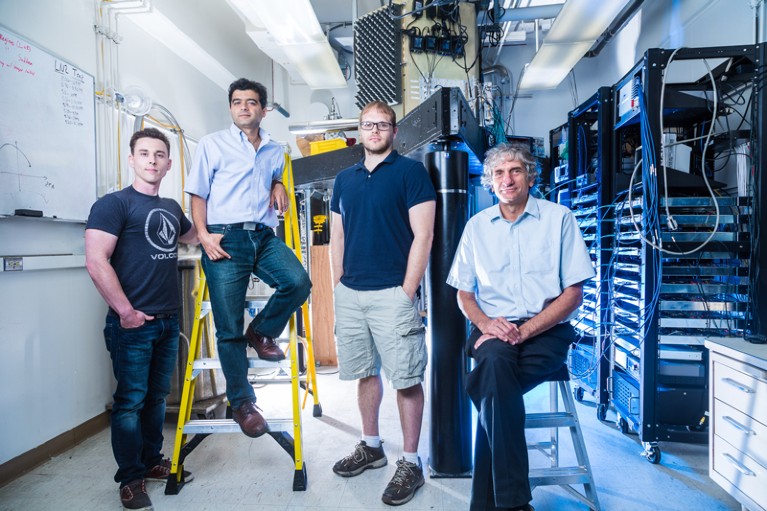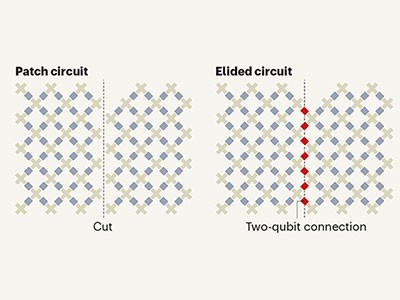
Members of Google’s AI quantum team, from left: Charles Neill, Pedram Roushan, Anthony Megrant and team leader John Martinis.Credit: Matt Perko/UCSB
Researchers led by Google’s AI Quantum team have demonstrated ‘quantum supremacy’ by creating a chip that performed a computational task faster than a classical computer. As we report in this issue, an achievement that the researchers say would have taken the world’s fastest supercomputer 10,000 years was completed in under 3 minutes (F. Arute et al. Nature 574, 505–510; 2019).
As the world digests this achievement — including the claim that some quantum computational tasks are beyond supercomputers — it is too early to say whether supremacy represents a new dawn for information technology. It could be that we are looking at quantum computing’s Kitty Hawk moment — a reference to the many decades between the Wright brothers’ first flight at Kitty Hawk in North Carolina, in 1903 and the advent of the jet age. At the very least, quantum computers as a routine part of life are likely to be decades or more into the future.
Read the paper: Quantum supremacy using a programmable superconducting processor
Still, this achievement in science and engineering should certainly not be underestimated. Research teams around the world have been working intensely to unleash the processing power of quantum phenomena: these include superposition, in which particles seem to have multiple states until they are observed; and entanglement, which describes how the properties of quantum systems can be tied together. If these behaviours can be more precisely controlled, they would generate exponential gains in processing power for certain tasks compared with today’s supercomputers. And that is what the team at Google has achieved.
Its chip, known as Sycamore, comprises just 53 individually controllable superconducting quantum bits (qubits), the basic building blocks of quantum computers. The team chose to calculate the outputs of a random quantum circuit — rather like a quantum random number generator. This is not an easy problem, and the Summit supercomputer at Oak Ridge National Laboratory in Tennessee, the world’s most powerful machine in its class, would have taken 10 millennia to complete it, the researchers say. Sycamore needed only 200 seconds.
Summit can call on more than 9,000 of the most powerful central processing units (8 billion transistors in each) and nearly 28,000 graphics processors (21 billion transistors each). With such raw computing power outgunned by just 53 qubits, it’s understandable that quantum computers are generating such excitement and optimism.
Quantum computing takes flight
But this demonstration of quantum supremacy is extremely limited. There’s a vast gap to be bridged before quantum computers can do more meaningful things — such as simulating the properties of materials or chemical reactions, or accelerating drug discovery.
For one thing, quantum computers are highly sensitive to environmental noise — including everyday phenomena such as temperature changes and electromagnetic fields. And researchers are a long way from being able to design out these and other obstacles.
Instead of proceeding with caution, a quantum gold rush is under way, with investors joining governments and companies to pour large sums of money into developing quantum technologies. Unrealistic expectations are being fuelled that powerful general-purpose quantum computers could soon be on the horizon. Such misguided optimism could be dangerous for the future of this still-fledgling field.
Such a landscape has created a flourishing network of quantum technologists, but those providing the funding will eventually seek a return on investment. There are already concerns that some firms are over-promising, which is why over-hyping this landmark demonstration could raise expectations further. Researchers fear that, if quantum computers fail to deliver anything useful soon, a ‘quantum winter’ could descend in which research progress slows, investment stalls and disillusion sets in.
The powerful processors that underpin today’s devices such as smartphones were developed from decades of sustained investment — often public investment — in research. Quantum processors will similarly require what innovation economists call ‘patient capital’.
Too often in the history of science and technology, expectations are raised, only for reality to get in the way. Quantum computers are still near the start of a long and unpredictable journey. As they encounter challenges and costs start to mount, researchers must know that they can reach their destination.

 Read the paper: Quantum supremacy using a programmable superconducting processor
Read the paper: Quantum supremacy using a programmable superconducting processor
 Quantum computing takes flight
Quantum computing takes flight
 Beyond quantum supremacy: the hunt for useful quantum computers
Beyond quantum supremacy: the hunt for useful quantum computers
 Quantum gold rush: the private funding pouring into quantum start-ups
Quantum gold rush: the private funding pouring into quantum start-ups








